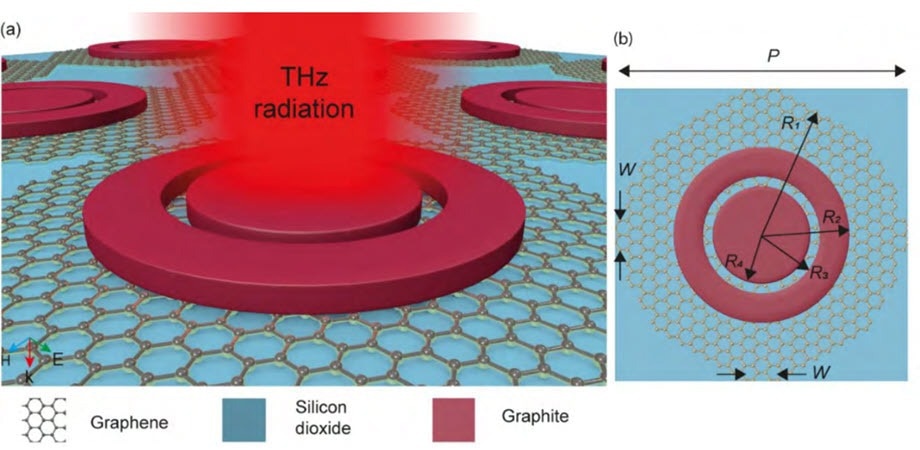Researchers use a carbon-based metamaterial to create a broadband, tunable absorber, opening the door to cutting-edge technological applications.
 Thanks to its highly symmetrical structure, combined with optimized geometric parameters and material selection, the proposed tunable carbon-based terahertz absorber could lead to substantial advances and new applications in THz technology. Image Credit: Nie, He, and Cao.
Thanks to its highly symmetrical structure, combined with optimized geometric parameters and material selection, the proposed tunable carbon-based terahertz absorber could lead to substantial advances and new applications in THz technology. Image Credit: Nie, He, and Cao.
Terahertz (THz) technology presents special opportunities for various applications, such as advanced sensing systems, biomedical imaging, and telecommunications. However, it has proven challenging to create high-performance components that fully realize the potential of THz technology due to the peculiarities of electromagnetic waves in the 0.1 to 10 THz range. The design of fundamental components like absorbers and filters is still quite difficult.
Thankfully, the development of metamaterials may result in creative solutions to these problems. With the development of manufacturing and processing technologies, two-dimensional (2D) patterned microstructures with distinctive electromagnetic properties in the THz range can now be produced, offering previously unheard-of control over signals at these frequencies.
While many different 2D metamaterial (also known as “metasurface”) absorbers have been proposed, the majority of the absorbers still have significant drawbacks. One prevalent issue is that a metasurface absorber’s electromagnetic performance is fixed once its structural design is decided upon and produced.
This untunable nature limits the potential uses for these kinds of devices. However, although there are metal-based metasurface absorbers that can be adjusted, using thin metal layers is not advised. This is because of a number of disadvantages, including the challenge of producing the required structures and the poor performance resulting from the intrinsic properties of metals.
In light of this, a Chinese research team has recently created a novel carbon-based tunable metasurface absorber with a tunable bandwidth that is extremely wide and falls within the THz range. Dr Wenhan Cao of ShanghaiTech University oversaw the research, which was just published in Advanced Photonics Nexus.
The proposed absorber is centered around the use of graphene and graphite microstructures as resonators and a graphite layer as a back-reflecting surface.
The repeating subunit, or ‘unit cell,’ in this THz metasurface absorber was strategically designed to optimize absorption efficiency mainly based upon four factors: geometry, material properties, polarization sensitivity, and tuning mechanisms.
Dr. Wenhan Cao, ShanghaiTech University
The absorber is composed of three thin layers geometrically. While the second layer is a straightforward dielectric that aids in dissipating unwanted electromagnetic waves, the top layer is a patterned conductive layer made up of an arrangement of concentric graphite rings connected by graphene wires. To maximize absorption efficiency, the third layer serves as an absorption layer, blocking THz waves from passing straight through the apparatus.
Its exceptional absorption in the THz range is a result of both the material choice and the absorber’s geometric design, which was refined via numerical analysis and simulations. The proposed absorber’s tunability, which results from a tunable Fermi level, is a noteworthy and crucial feature. This parameter, which establishes the distribution of electrons at various energy levels, is crucial to materials science and semiconductor technology.
By applying a voltage to the graphene layer, it is possible to modify its Fermi level, which in turn enables one to easily fine-tune the absorption bandwidth.
At a Fermi level of 1 eV, the proposed absorber can achieve an impressively wide bandwidth of 8.99 THz, delivering over 90 percent absorption within the frequency range of 7.24 to 16.23 THz, with two distinct resonance peaks at 8.35 THz and 14.70 THz.
Dr. Wenhan Cao, ShanghaiTech University
The remarkable insensitivity of the proposed design to the polarization angle of incident radiation is another noteworthy advantage. The absorber’s unit cell uses concentric rings, naturally resulting in this advantageous property. The circle’s perfect symmetry allows the absorber to maintain a high absorption rate at up to 50° incident angles.
Overall, the many benefits of the proposed design, combined with its elegant simplicity, represent a true breakthrough in THz technology.
The proposed absorber provides an ultra-thin and simple metal-free structure with a wide and tunable absorption bandwidth at a low thickness, which greatly enhances its applicability. These advantages go beyond those of other reported absorbers.
Dr. Wenhan Cao, ShanghaiTech University
Cao is satisfied with the results. THz devices may soon find their way into commonplace technology, particularly in the areas of communications and medicine, as well as more specialized fields like biology and materials science.
Journal Reference:
Nie, A., et al. (2024).Carbon-based ultrabroadband tunable terahertz metasurface absorber. SPIE Digital Library. doi.org/10.1117/1.APN.3.1.016007.